You have no items in your shopping cart.
Tang Chongling Mausoleum
Introducing Chongling Mausoleum of Tang Dynasty
Tang Chongling Mausoleum is located in Jingyang County, 52 km north of Xi'an. Chongling Mausoleum is where Emperor Dezong of Tang Dynasty was buried. Dezong was the 9th emperor of the Tang Dynasty who ruled China from 779 to 805. Emperor Dezong started out as a diligent and frugal emperor and he tried to reform the governmental finances by introducing new tax laws. His attempts to destroy the powerful regional warlords and the subsequent mismanagement of those campaigns, however, resulted in a number of rebellions that nearly destroyed him and the Tang Dynasty. After those events, he dealt cautiously with the regional governors, causing warlordism to become unchecked, and his trust of eunuchs caused the eunuchs' power to rise greatly. After Emperor Dezong died on Feb 25, 805, at the age of 64, he was buried at Chongling Mausoleum on Oct 14, 805. Chongling Mausoleum was built into the mountain face of 1405 meter elevated Mount Cuo'e. It is recorded that Chongling Mausoleum was looted in 908 by the local governor of Yaozhou during the period of Five Dynasties after the Tang Dynasty was overthrown in 907.
Watch this video showcasing Chongling Mausoleum of Tang Dynasty
Kind Notice: This video is not available in China (YouTube is blocked). If you are in China, click here.
Chongling Mausoleum of Tang Dynasty Fast Facts
• Chinese Name: Tang Yuan Ling 唐崇陵
• Best Time to Visit: All year round
• Recommended Visiting Hours: 2 hours
• Distance from Xian: 58 km (36 mi)
• Opening Hours: All day
• Entrance Fee: Free
• Address: Shimaxiang Village, Jingyang County, Shaanxi Province
What to expect at Chongling Mausoleum of Tang Dynasty
Chongling Mausoleum belongs to the Mid-Tang period (766-835). As a result of An Lushan Rebellion between the years 755 and 763 CE, the Tang Dynasty was greatly weakened and the imperial court no longer had adequate wealth for the construction of imperial tombs. Stone sculptures turned to be small in sizes and coarse in sculpture skills. Chongling Mausoleum followed the rules set by Tailing Mausoleum, the first Mid-Tang period imperial tomb. Existing stone sculptures of the Spirit Way of Chongling Mausoleum include a pair ornamental columns, a pair of winged horses, one ostrich (west ostrich is missing), 9 saddled horses (all in broken condition), 9 stone statues of civil officials, and 9 stone statues of military officials. The guarding lions of South Vermilion Bird Gate and North Black Tortoise Gate are well preserved. The two guarding lions of East Azure Dragon Gate and one lion of West White Tiger Gate were destroyed during the Cultural Revolution.
The Spirit Way
Spirit way is the ornate road leading to a Chinese imperial tomb. It symbolizes the passage of the soul the dead emperor into the world of the spirits. It is typically arranged along the north–south axis outside the south Vermilion Bird Gate. The Spirit Way of Chongling Mausoleum is 596 meters long from south to north and 71 meters wide from east to west. Taking Tailing Mausoleum as a model, the sculptures of Chongling Mausoleum include a pair of Ornamental Columns, a pair of Winged Horses, a pair of Ostriches (only one is standing now), five pairs of saddled horses (all in broken condition), 10 civil officials (one missing now) on the east side of the spirit way and 10 military officials (one missing) on the west side of the spirit way.
The Ornamental Columns
The ornamental columns of Tang Dynasty imperial tombs were typically made up of three components. At the bottom is a square column base, decorated with bas-relief depictions of auspicious symbols. Above is an octahedral column which reflects the eight directions of the "Ba-Gua Octagon," or Eight Trigrams. The column is topped by a pearl on a round cap. This design of the columns symbolizes the ancient Chinese understanding of the universe, that is, the heaven was round and the earth was square. Putting ornamental columns in front of imperial mausoleums proclaimed the eternal life of the deceased emperor. Both of Tailing Mausoleum's ornamental columns are 7.88 meters tall. Its square shaped pedestals were carved with upside down lotus flower. The column bodies were octahedral etched with bas-relief of clouds and plants. Atop the column is a huge pearl.
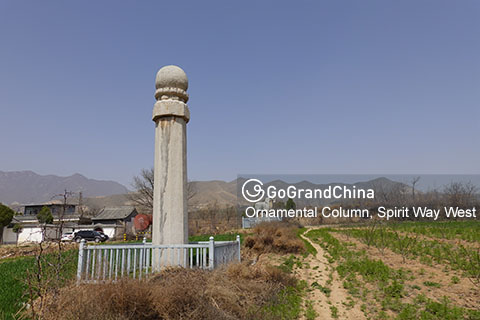
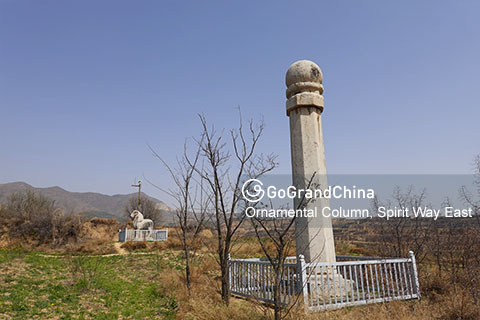
Winged Horses
Winged Horses are auspicious animals which symbolize power and fortune in Ancient China. The winged horses of Chongling Mausoleum stand 2.69 meters tall and the body of the winged horse is 2.53 meters long. The winged horses featured a single horn, long necks and legs and wings with three quills. Winged horse was supposed to carry the deceased emperor's soul to the world of spirits.
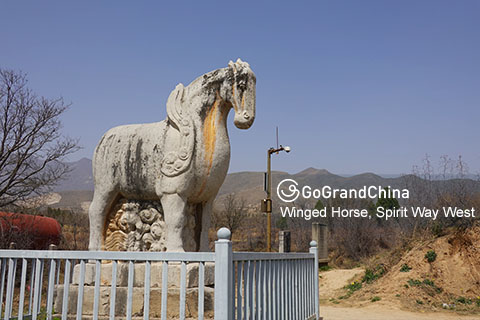
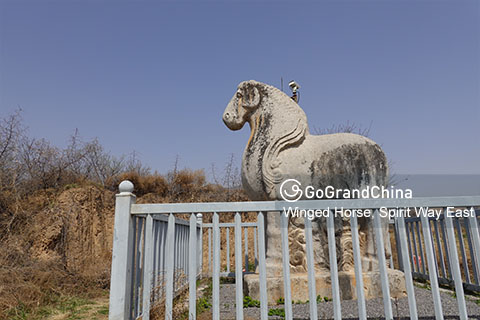
Ostriches
Ostrich is not native to China. It was a tribute to the Tang imperial court from central Asian countries. The Khan of the Western Turks presented an ostrich to the Tang court in 620 and the Tushara Kingdom sent another in 650. Qianling Tomb of the Tang Dynasty was the first to use ostrich on the Spirit Way. Imperial tombs built after Qianling Mausoleum followed suit. Ostriches were placed on the Spirit Way as a sign of the greatness of the Chinese emperor and a symbol of the Tang Dynasty’s power and influence over its foreign neighbors. The ostriches of Chongling Mausoleum were carved on a 1.52 meter tall and 2.05 meter wide stone screen. Today, only the ostrich on east side of spirit way is still standing.
Saddled Horses
Saddled horses were horses of the guard of honor. Five pairs of saddled horses would be arranged facing each other along the spirit way when they were first placed during the funeral. All of Chongling's saddled horses were broken during the Cultural Revolution between 1966 and 1976. Today, 9 broken horses without legs are in existence, four on the east side and five on the west side of the Spirit Way.
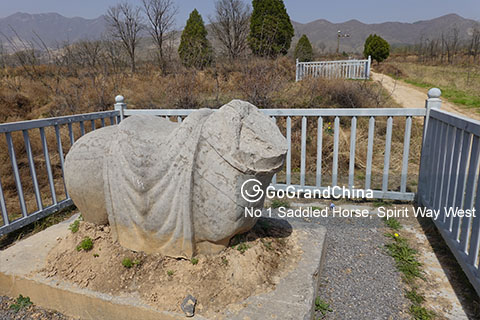
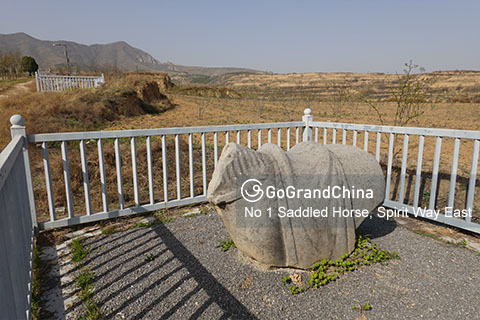
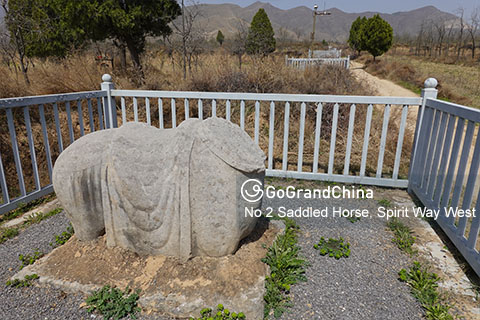
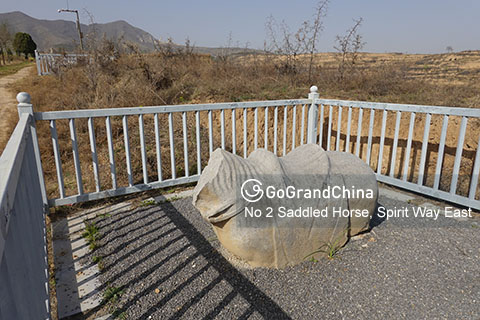
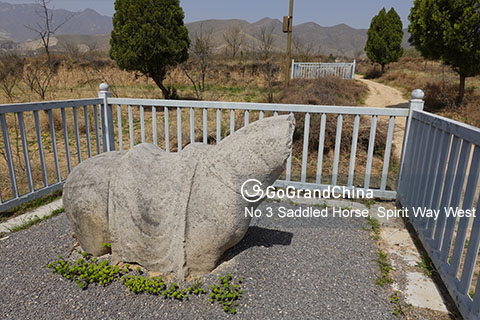
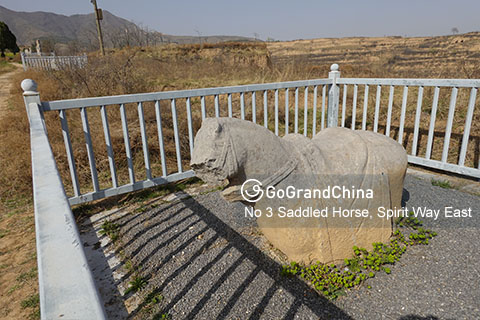
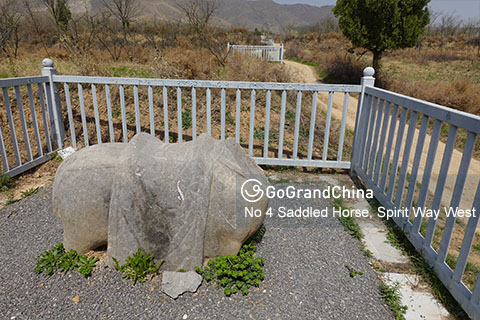
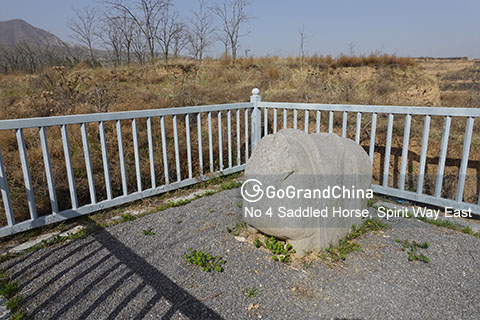
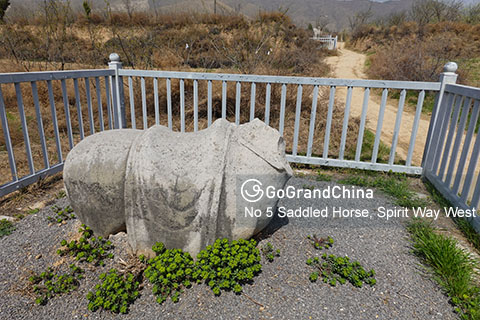
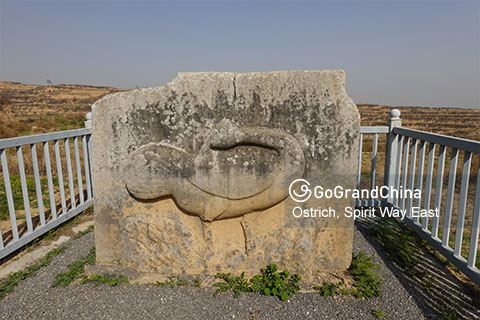
Guardian Statues of Civil & Military Officials
The guardian statues of civil and military officials are called Wengzhong in Chinese. Wengzhong was a giant man of great strength and a general of China's first emperor, Qin Shihuang. He was garrisoned in Lintao, the west end of the Qin Dynasty built Great Wall of China and had earned merit in the fight against the Huns. After his death, Emperor Qin Shihuang ordered a bronze statue of Wengzhong to be made after him, placed outside his palace in Xianyang and from then on, bronze or stone statues of humans were called Wengzhong. These stone guardian statues of Wengzhong symbolize real civil and military officials guarding the imperial tombs. Taking Tailing Mausoleum as a model, 10 statues of civil officials were placed on the east side of the spirit way and 10 statues of military officials on the west side of the spirit way. Civil officials are clasping a note-tablet while military officials are holding a sword. Today, 9 civil officials and 9 military officials are standing. Their heights are between 2.05 and 2.85 meters.
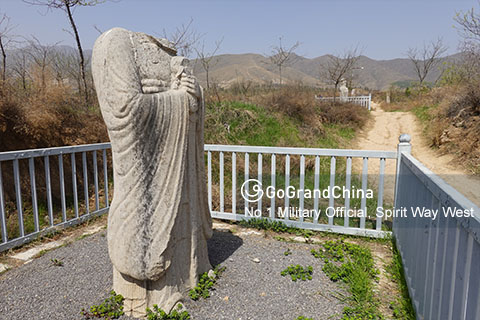
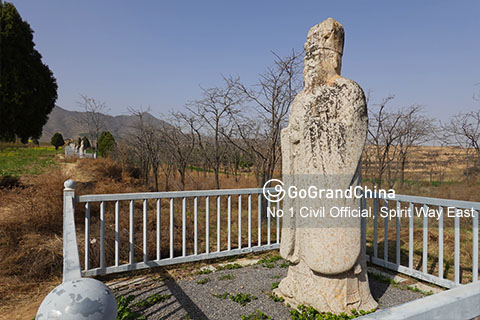
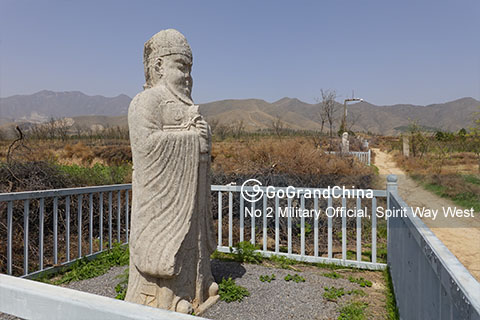
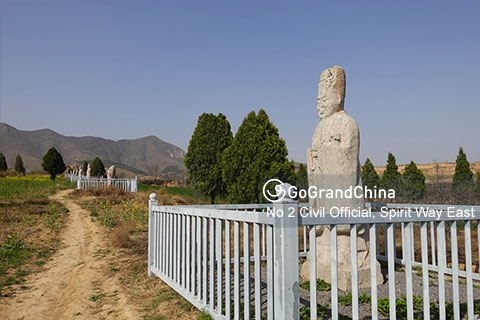
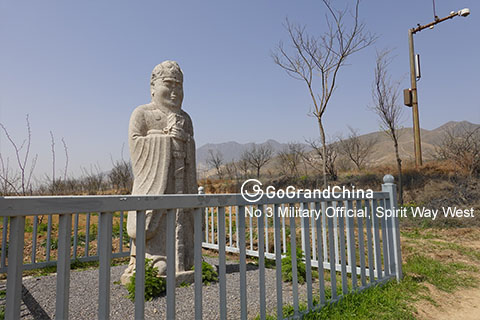
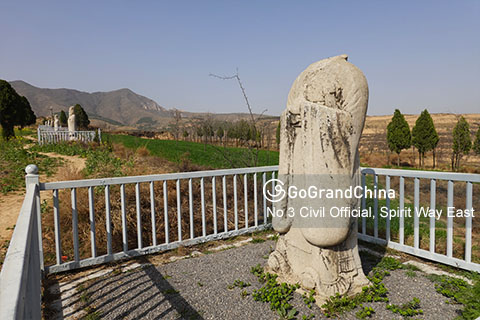
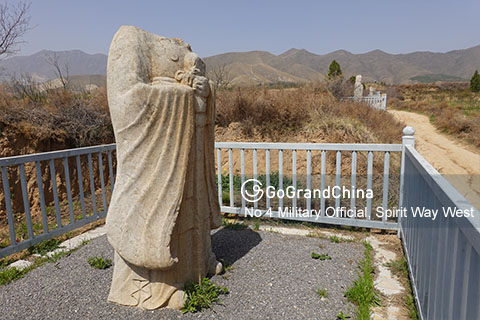
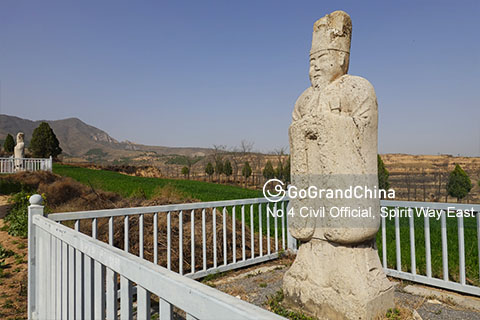
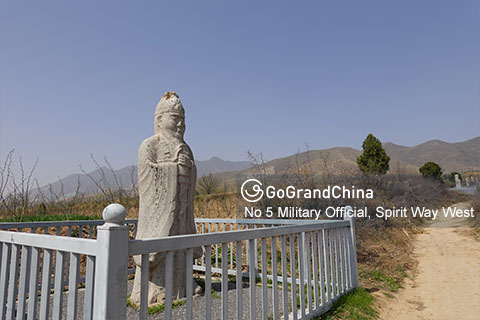
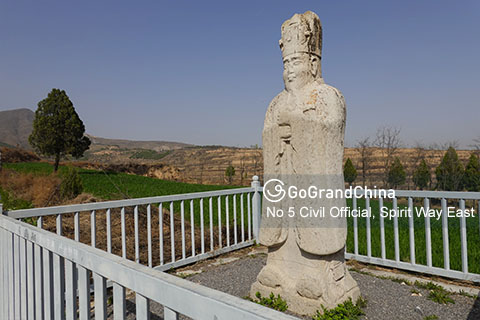
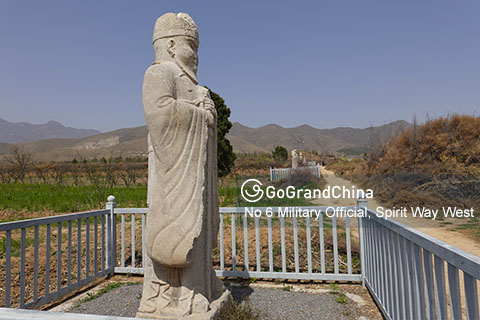
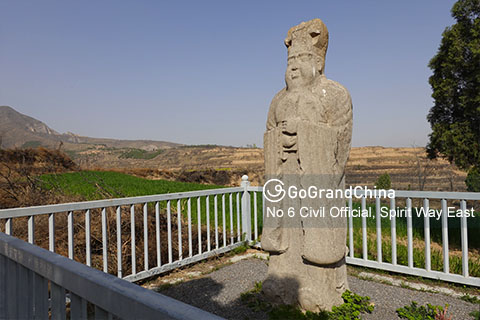
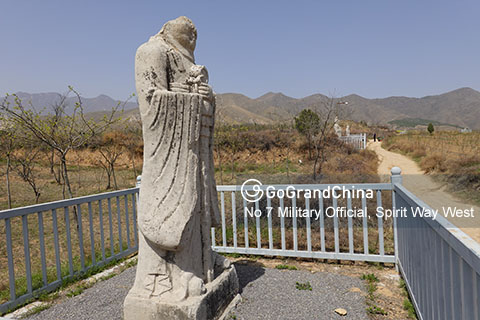
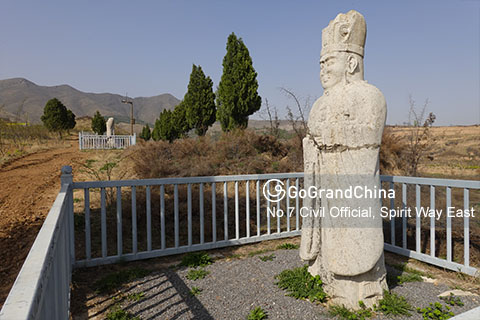
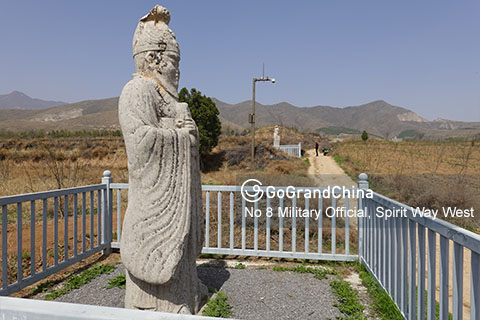
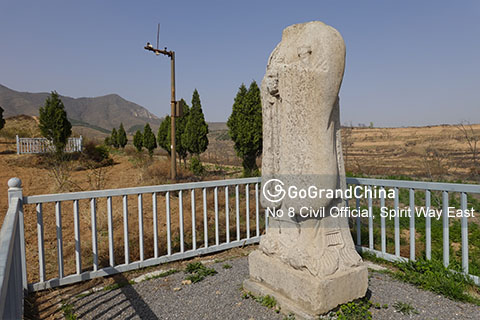
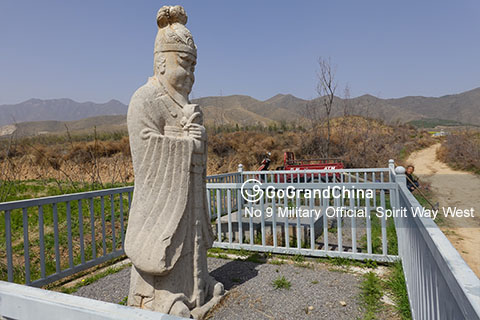
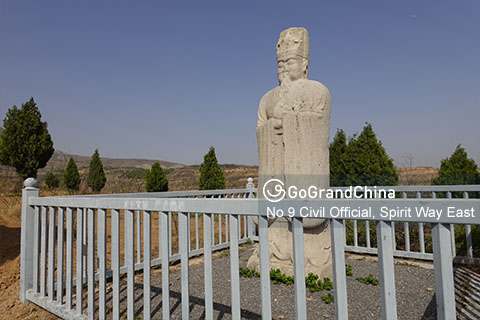
The South Vermilion Bird Gate
The vermilion bird is one of the Four Symbols of the Chinese constellations representing the direction south. It is described as a red bird that resembles a pheasant with a five-colored plumage and is perpetually covered in flames. The South Vermilion Bird Gate symbolizes the Gate of Heavenly Succession, the south gate of the Palace City of Chang'an (today's Xian) where Tang Dynasty emperors lived with his family. The vermilion bird gate used to be connected with the inner wall of the tomb to the East Azure Dragon Gate, West White Tiger Gate and North Black Tortoise Gate. Today, two crouching lions still stand guard at the ruins of Vermilion Bird Gate Towers. The lion sculptures are about 1.59 to 1.75 meters high. General speaking, Tang Dynasty male stone lions featured a closed mouth and their mane would be in tight curls; female stone lions would have an open mouth and naturally drooping mane.
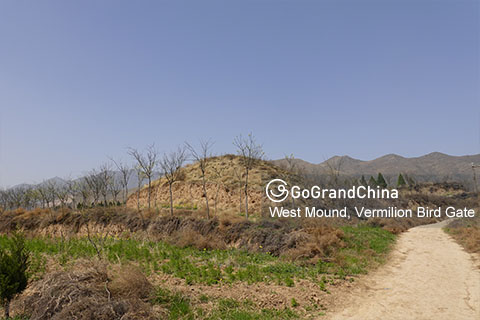
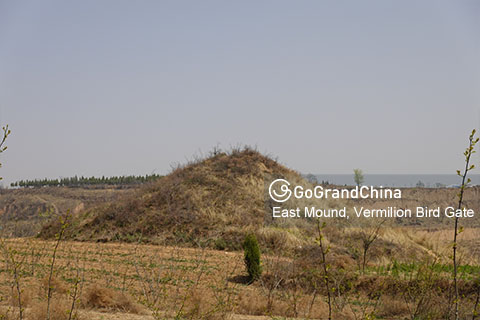
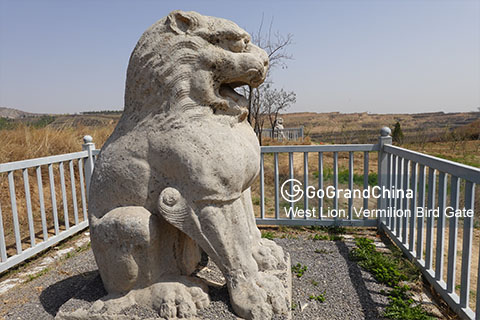
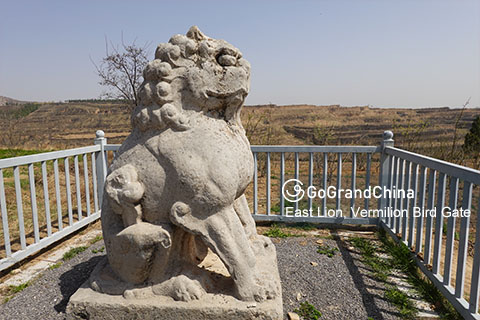
The East Azure Dragon Gate
The azure dragon is one of the Four Symbols of the Chinese constellations representing the direction east. The East Azure Dragon Gate used to be connected by the tomb's inner wall with the South Vermilion Bird Gate, West White Tiger Gate and North Black Tortoise Gate. The two stone lions guarding this gate were broken into pieces in the campaign of Elimination of Four Olds during the Cultural Revolution incited by Chairman Mao Zedong in 1960s. Today, only the two mounds stand guard at the Azure Dragon Gate of Chongling Mausoleum.
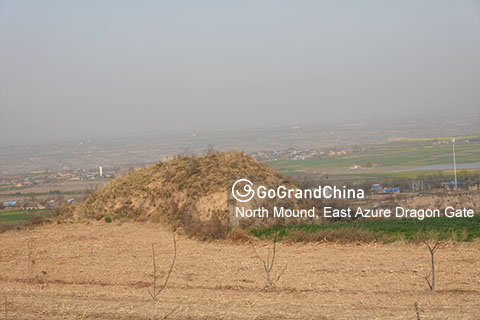
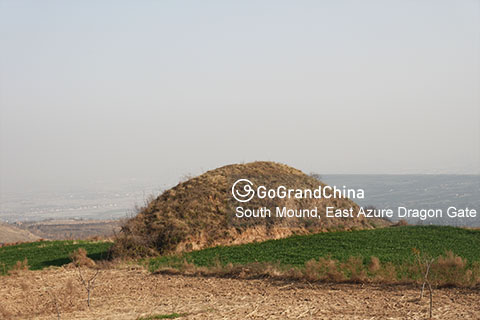
The West White Tiger Gate
The white tiger is one of the Four Symbols of the Chinese constellations representing the direction west. The White Tiger Gate used to be connected by the inner wall of the tomb with the south Vermilion Bird Gate, east Azure Dragon Gate and north Black Tortoise Gate. The south male lion of Chongling's West White Tiger Gate was damaged during the Cultural Revolution in 1960s. Broken pieces of the lion can be identified at the foot of the mountain. Today, the two earthworks of the gate towers are still standing; the lonely north lion is still guarding the gate.
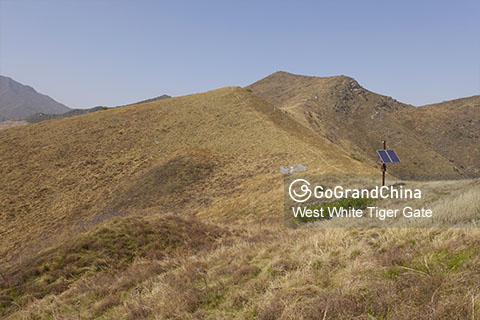
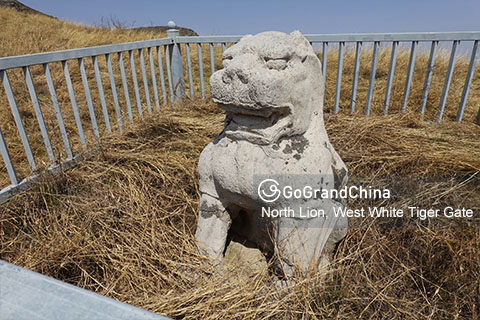
How to get to Chongling Mausoleum of Tang Dynasty
• Chongling Mausoleum lies 58 km (36 mi) north of downtown Xian.
• Rent a car/bus from GGC to enjoy a hassle free private transfer from hotels in Xian to Chongling Mausoleum.
There are no products matching the selection.

